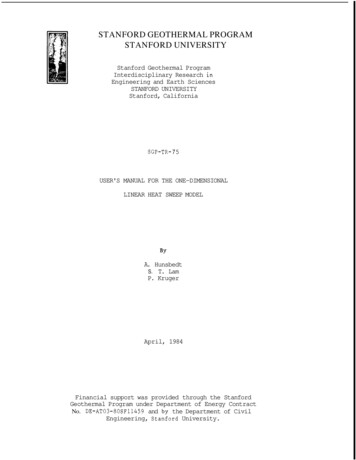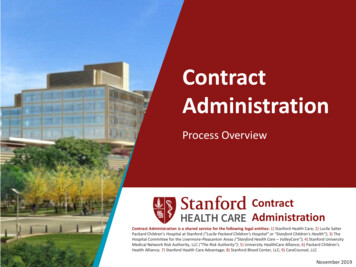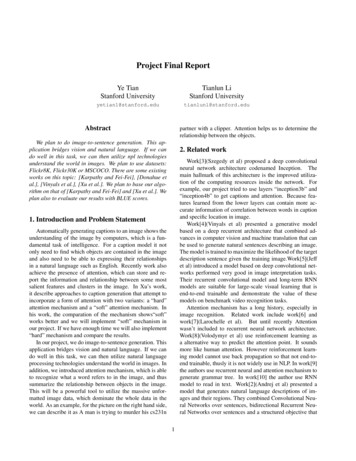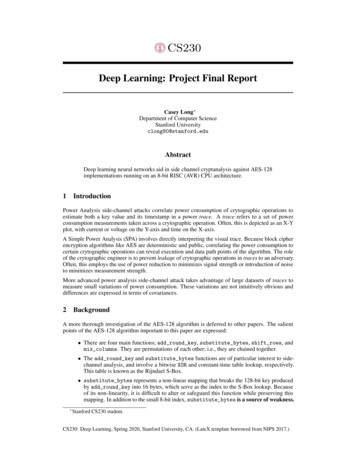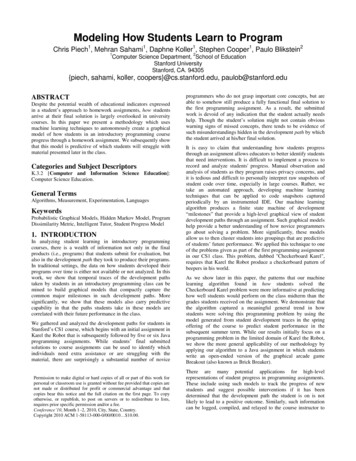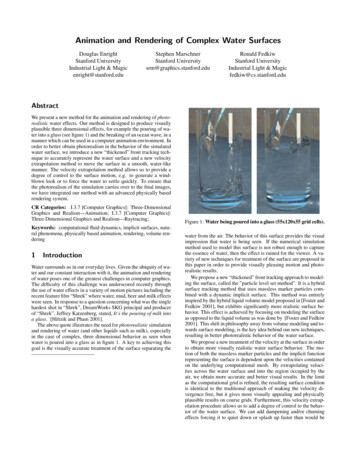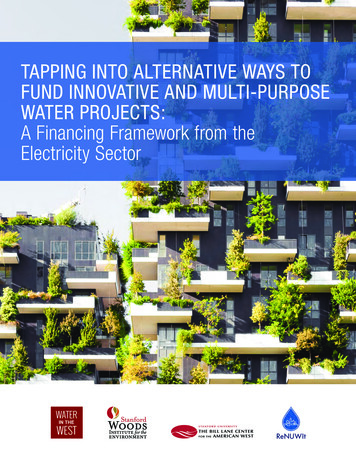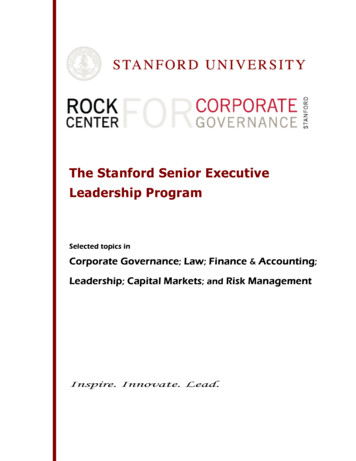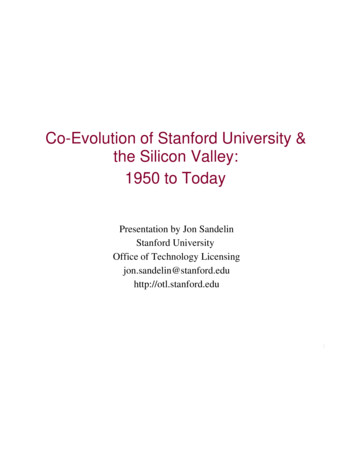
Transcription
Co-Evolution of Stanford University &the Silicon Valley:1950 to TodayPresentation by Jon SandelinStanford UniversityOffice of Technology ord.edu1
Creating Silicon ValleyFFFFFFFFStanford University: 1950 vs. TodaySilicon Valley: 1950 vs. TodayThe Architects of Stanford’s GrowthAvailable ResourcesObjectivesTacticsThe Stanford Research ParkThe Future of Silicon Valley2
Stanford University: 1950 vs. embersTuition4,8006,7002,8008,2003701,800 600 33,000Endowment 44M 14B3
Stanford University: 1950 vs. TodayNational Medalof Science030Nobel PrizeWinners028Annual Budget 100M 3.2BSponsoredResearch 11M 1.06B4
SummaryFFIn 1950, Stanford was a leadingregionally-known university strugglingfinanciallyIn 2007, Stanford is a top-tierinternationally-known university that isfinancially secure and a key part of theSilicon Valley Cluster5
Silicon Valley in 1950FFDid not exist (mostly fruit orchards)First lease in Stanford Industrial Parkto Varian Corporation signed inOctober, 1951; Generally referred toas the birth of Silicon Valley6
Silicon Valley TodayFFFFFFFFFA Region of 1500 Square Miles2.3 million people1.35 million jobsHeadquarters for over 400 public companiesAverage salary of 65,000Venture Capital Investments of over 8 billionAverage lease rate of 1.50 square foot (20% vacancy rate)A return to 1997/98 levels after Internet Boom and BustThe Future: Convergence of Biotechnologies; InformationTechnologies; and Nanotechnologies7
SummaryFFIn 1950, Silicon Valley did not exist, butStanford University was planting the seedsfrom which it would grow and developIn 2007, emerging from recovery mode, it has:(1) the technical, social, and educationalinfrastructure; (2) capital sources; and (3)intellectual pool of talent to surge forward inthe coming years. It is widely viewed as theinternational standard for hi-tech regionalgrowth and wealth creation.8
Waves of Innovationin Silicon Valley HistoryEcology of skillsandorganizations9
Stanford: A Wellspring ofInnovation for the Silicon Valley·Stanford graduates, faculty and staff have launched approximately1200 companies in the last 50 years·More than 50% of Silicon Valley product is due to companiesstarted by Stanford alumniWith HPSilicon Valley100 companies startedwith Stanford teamsand technology1988Without HP1996With HPWithout HP 40 BIL 30 BIL 100 BIL 66 BIL 25 BIL 15 BIL 65 BIL 32 BIL10Source: Jim Gibbons
The ArchitectsFFWallace Sterling: Stanford President 1949 - 1968Frederick Terman: Dean of School of Engineering 1945- 1955 and Provost 1955 - 1965– Undergraduate degree Stanford; Graduate degreeMIT, Advisor was Vannevar Bush (“Science; TheEndless Frontier”)– Returned to MIT in WWII; Developed strongcontacts within government agencies– Academic “Steeples of Excellence” philosophy– Referred to as “the Father of Silicon Valley11
Knowledge Cities and Smokeless Industry:Sterling and Terman’s Plans for Improving StanfordDevelopment of Stanford LandsFederal Programs for Support of Research12
Available ResourcesFFFFLand: 8800 acres, with 1200 acres in the AcademicPreserve (property-tax exempt land where universitybuildings are located)Regional Quality of LifeLinkages to Federal funding agencies and theimpending flood of Government Sponsored Research atuniversities (the Cold War effect)A Passion to succeed13
ObjectivesFFFRecruit Top-Tier Faculty in targeted disciplinesRecruit Top-Tier Graduate Students, to remain in theregion following graduation (intellectual pool of talent)Bring Hi-Tech industry into the region near Stanford––––––To hire graduating studentsTo participate in research collaborationsTo support and participate in Industrial Affiliates ProgramsTo sponsor research at StanfordTo provide consulting work for facultyAs a source of gifts and donations, both from companies andindividuals14
Tactics (1): FacultyFFFEncourage Faculty entrepreneurship; to identifyresearch that outside “patrons” would supportIncrease number of Graduate students perfaculty member in targeted disciplinesSalary-splitting: Faculty expected to findoutside funding for 50% of salary (freeinguniversity to compete for added top-tierfaculty)15
197619771978197919801981Figure 5: Engineering School Ph.D. Production180160140120100ElectricalPh.D. Total in Enginerring80604020016
Tactics (2): Land UseFFFCampus Housing for Faculty and SeniorStaff as recruitment toolCommercial use to generate income; e.g.Stanford Shopping CenterProvide low cost land leases in theStanford Industrial Park17
Tactics (3): IndustryFFFFFEncourage graduating students and faculty to startcompanies (H/P example; over 1200 companies to dateaccounting for over 50% of Silicon Valley output)Create Industrial Park with inexpensive land leases(now over 150 companies in the “Research” Park)Offer cutting-edge education to company employees(Engineering Honors Cooperative Program; nowreaches hundreds of companies over the internet)Assist in development of Venture Capital IndustryForm Industrial Affiliates Programs (now over 40)18
R&D FundingFFFFFGovernment Research Funding: Provides the funding for salarysplitting of professors and for graduate student stipends. Thisincreased the number and quality of the intellectual capital that wascritical to the growth of Silicon Valley; 900M to Stanford in2006; 27B to all U.S. UniversitiesSmall Business Innovation Research (SBIR) grants: FromGovernment agencies by competitive bidding; Over 2B awardedin U.S. in 2006; STTR grants can include funding to universitiesIndustry Research Funding: Created partnerships and researchresults that strengthened the competitive position of Silicon Valleycompanies; 50M to Stanford in 2006; 2.3B to U.S. UniversitiesPrivate Foundations: Rockefeller; Gates; Ford; etc.; 48M toStanford in 2006Gifts: Primarily from wealthy Alumni; 911M to Stanford in 200619
Start-up Company FundingFAngels: Typically high wealth individuals that cluster into groups toreview investment opportunities; e.g. Band of Angels– Stanford faculty who have made substantial wealth via involvement withstart-up companies (typically by taking a leave of absence to be a ChiefTechnical Officer) have formed an informal angels investment group thatprovide seed funding for many Stanford start-upsFVenture Capital firms: First raise a money fund (typically 100M to 1B);then review business plans to select investments– First V/C style investment (in Watkins/Johnson), by Kern County LandCompany in 1958, was facilitated by Fredric Terman of Stanford– A very early V/C firm; the Kleiner, Perkins, Kaufield & Byers V/C group wasco-founded with Stanford faculty; as was the Mayfield fund in 1968– About 1/3 of all V/C investments (over 8B in 2006) is in the Silicon Valley20
Technology ManagementFStanford Office of Technology Licensing (OTL)– Founded in 1969 with staff of 2 and licensing income of 55k– Today a staff of 23 with licensing income of 61M in 2006 from 470 activelicenses; cumulative licensing income since 1969 exceeds 1B– Over 200 start-up companies have been licensed; Largest return from sale ofequity is 336M in 2005 when Google stock was soldFAssociation of University Technology Managers (AUTM)– Formed in 1975 when 10 universities each put up 100; early focus was onpassage of the Bayh/Dole law (signed in 1980)– Today has over 3,500 members from all over the world with about 55%university related people; rest are from industry and support groups (patentfirms, investment firms, accounting firms, etc.)– Services include national and regional meetings, basic to advanced courses, aNewsletter and Journal, a four-volume Technology Transfer Practice Manual,and a comprehensive Annual Survey. A low cost ( 25) electronic membershipis available for developing countries21
2004 AUTM SurveyFFFFFF 1,426 Million in Royalties 54 Billion in Licensed Products Sales435,000 new Jobs18,178 new Invention Disclosures11,089 new Patent filings5,327 new Licenses (10% to Start-UpCompanies)22
Invention 000200001991 1993 1995 1997 1999 2001 2003InventionDisclosures23
Patents Filed120001000080006000Patents Filed4000200001991 1993 1995 1997 1999 2001 200324
Licenses Granted6000500040003000Licenses Granted2000100001991199419972000200325
Royalty Income1600140012001000800600Royalties inMillions USD40020001991 1993 1995 1997 1999 2001 200326
Stanford Research ParkFFFFFFOriginal Purpose: Earn IncomeRevised Purpose: Place R&D focusedcompanies near StanfordAuthorized 1951 will 209 acre allocationFirst Tenant 1953: Varian AssociatesShockley Transistor Company 1955Hewlett/Packard World Headquarters 195627
Stanford Research Park:The BeginningFFFFUniversity in tight control of Park development(no outside developer)Rigid specifications for buildings; withLandscaping/open space demandsScreening of potential tenants to ensurecompliance with university objectivesPrepaid 99 year leases for early tenants28
Stanford Research Park:Attracting TenantsFFFFFHonors Cooperative ProgramStanford Affiliates ProgramsAn Ideal Climate; Close to San FranciscoClose to Faculty ConsultingInteraction with and hiring of Students29
Stanford Research Park: GrowthFFFFFF1960: 40 companies in the Park1960: Expansion from 209 acres to 450 acres1985: Over 100 companies in Park1985: Expansion to 660 acres1985: Stanford: 5 million from rents; 1million from investment income1985: Palo Alto: 20 million from net utilityincome, sales taxes, and property taxes30
Stanford Research Park TodayFFF150 Companies with 23,000 employees700 acres with 10 million sq. ft. of officeand facility space in 162 buildingsIndustry areas represented are electronics,space, biotechnology, computer hardware& software; plus law offices andconsulting firms31
The Future for Silicon ValleyFFFNext Wave: Convergence of bio-, info-, andnanotechnologyAssets: Entrepreneurial Culture & Habitat;Abundant Capital; Densely-Networked SkilledLabor Pool; Stanford University (e.g., Centerfor BioSciences & BioEngineering; and Officeof Technology Licensing)www.jointventure.org32
Stanford Case StudiesPresentation by Jon SandelinStanford UniversityOffice of Technology ord.edu33
Some Stanford Case StudiesFFFF1970 WYLBUR 1Million1971 FM Sound Synthesis 23M– Inventor: Professor John Chowning, Department OfMusic1974 Genetic Engineering 255Million– Inventors: Professor Stanley Cohen (StanfordGenetics Dept) & Professor Herbert Boyer (UCSF)1996 Google 336Million– Inventors: Graduate Students Larry Page andSergey Brin, Computer Science Department34
The Wylbur StoryFFFFFThe Beginnings - 1970The Company Visit - 1971The Threatening Letter - 1972OTL to the Rescue: Registration ofCopyright and TrademarkA Happy Ending: A very successfullicensing arrangement35
Wylbur Licensing HistoryFFFFF1972-1976: Non-exclusive Site Licenses for one time fee of 2,0001976: Exclusive Software Distribution Agreement with On-Line BusinessSystems (OBS); 15% royalty on sales of Wylbur (Stanford can stilldistribute Wylbur to education institutions); Amendment 1 changed to15% 1st 250k, then 20% to 350k, then 25%; Amendment 2 added 6%royalty on service/maintenance fees1982: Revised Agreement with OBS with royalties of: 7.5% for 1st 700k; 10% to 1M; 12.5% to 1.25M; 20% thereafter1983: Addition Trademark Licensing Agreement with OBS allowing useof Wylbur trademark for added 1% royalty1994: Royalties end; Product is out-dated; Total royalties of just under 1M36
FM Sound SynthesisFFFFF1971/73: Marketed in U.S. No one interested1974: Meetings with Yamaha in L.A. & Japan; Yamaha Engineer(Mr. Ishimura) predicts product in 10 years; Letter Agreementsigned3/75: Exclusive License Agreement signed for sale of musicalinstruments5/75: Patent Application Filed (issued 4/77 and expired 4/94)5/81: Replacement Agreement Signed (after 5 amendments toinitial Agreement) to now include royalties on sales of computerchips37
FM Sound Synthesis(2)FFFFF1984 Yamaha DX Series of Sound SynthesisKeyboards Introduced: Very successful product line1980s: Sound Generation Chips for PCs1990s: Mr. Ishimura becomes President of Yamaha1994: Patent Expires; Royalties endToday: Musical tones in cell phones use FM SoundSynthesis technology disclosed in 197138
FM Sound Synthesis Royalty Income54.543.532.521.510.501990 1992 1994Royalties inMillions USD39
Genetic EngineeringFFFFF11/72: Meeting in Hawaii Restaurant3/73: Successful Results11/73: Publication of Results (Establishes Patent BarDate of 11/74)5/74 Newspaper article on genetic engineeringforwarded to Niels Reimers; He meets with inventorswho do not wish to file for a patent6/74 - 11/74: Inventors agree to a patent; then mustobtain ownership rights from research sponsors40
Genetic Engineering(2)FFFF11/74: Process Patent Application Filed (Issued 12/2/80 andexpired 12/2/97; Open Patent Prosecution; Two ContinuationApplications later filed on Products12/74: Call for safety guidelines for genetic engineering research(Issued by NIH in 1975)1976: Article in Science magazine on safety issues lead to NIHand Congressional Reviews; Outcome is an ok for Stanford toproceed with patenting and licensing8/81: Non-exclusive licenses made available with 12/15 deadlineto get favorable terms; License is printed in booklet form todiscourage change requests41
Genetic Engineering(3)FFavorable Terms– Low earned royalty rate (1/2 to 1%)– 10k Issue Fee & 10K/year; Issue Fee and first five years get5x credit ( 300k) against earned royaltiesFFF12/81: 73 licenses signed and submited1985: First Licensed Product Sold: Human Insulinmade by Genentech & marketed by Eli Lily under tradename Humulin12/97: Patents expire with over 400 licenses in placeworld-wide42
Google (Googol)FFFFF1996: “PageRank” invention disclosed by Larry Page (SergeyBrin technologies added later)1/97: PageRank marketed to InfoSeek, Excite, AltaVista, andDeutsch Telecom3/97: Chairman of CSD wishes to know what will be licensed andwho gets credit: Research sponsor is 3.4M NSF Digital LibrariesProject1/98: Provisional Patent filed (Issued 9/01)7/98: InfoSeek offers 40K for non-exclusive or 30k/year for 5years for exclusive license43
Google (Googol) (2)FFFFF7/98: Page rejects offer and decides to start a company; has AngelInvestors willing to back him (e.g., Andy Bectelsheim)8/98: About 1M raised from Angel Investors9/98: Change in strategy: Will start a full service internet search businessnow utilizing technology developed by Sergey Brin10/98: Chairman of CSD requests a review; Listing of all components forGoogle prepared; Review and sign-off from other researchers on DigitalLibraries Project3/99: License Agreement signed– Extensive list of “Licensed Technology”– Option to “Joint Inventions”– Otherwise typical terms for a start-up license; e.g., equity in lieu of cash for theLicense Issue Royalty44
Google (Googol) (3)FFFFF6/99: 25M from Kleiner Perkins (John Doerr) and SequoiaCapital (Michael Moritz); On condition that a qualified CEO ishired soon9/01: First patent Issues; Two Joint Patents pending8/04: Google IPO via Auction Format; 2B raised2005: Stanford sells equity for 336M (over 1.8M shares due tothree 2 for 1 stock splits and no dilution as no venture fundingrounds after 6/99)2005: Page and Brin each worth over 10B45
THE ENDFThank You for your Attention!46
10 Stanford: A Wellspring of Innovation for the Silicon Valley ·Stanford graduates, faculty and staff have launched approximately 1200 companies in the last 50 years ·More than 50% of Silicon Valley product is due to companies started by Stanford alumni 25 BIL 15 BIL 65 BIL 32 BIL 100 companies started
